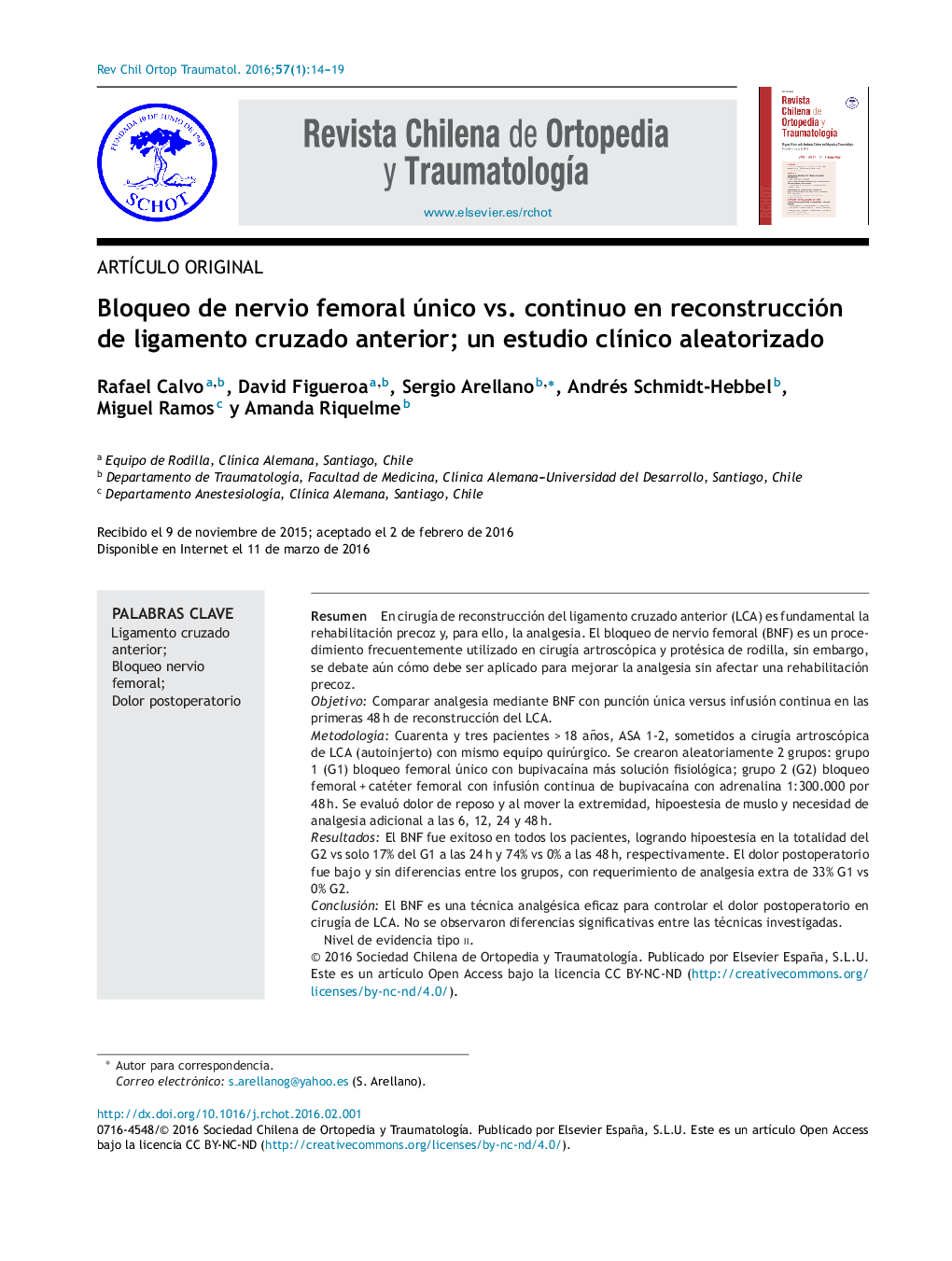| Article ID | Journal | Published Year | Pages | File Type |
|---|---|---|---|---|
| 4086003 | Revista Chilena de Ortopedia y Traumatología | 2016 | 6 Pages |
ResumenEn cirugía de reconstrucción del ligamento cruzado anterior (LCA) es fundamental la rehabilitación precoz y, para ello, la analgesia. El bloqueo de nervio femoral (BNF) es un procedimiento frecuentemente utilizado en cirugía artroscópica y protésica de rodilla, sin embargo, se debate aún cómo debe ser aplicado para mejorar la analgesia sin afectar una rehabilitación precoz.ObjetivoComparar analgesia mediante BNF con punción única versus infusión continua en las primeras 48 h de reconstrucción del LCA.MetodologíaCuarenta y tres pacientes > 18 años, ASA 1-2, sometidos a cirugía artroscópica de LCA (autoinjerto) con mismo equipo quirúrgico. Se crearon aleatoriamente 2 grupos: grupo 1 (G1) bloqueo femoral único con bupivacaína más solución fisiológica; grupo 2 (G2) bloqueo femoral + catéter femoral con infusión continua de bupivacaína con adrenalina 1:300.000 por 48 h. Se evaluó dolor de reposo y al mover la extremidad, hipoestesia de muslo y necesidad de analgesia adicional a las 6, 12, 24 y 48 h.ResultadosEl BNF fue exitoso en todos los pacientes, logrando hipoestesia en la totalidad del G2 vs solo 17% del G1 a las 24 h y 74% vs 0% a las 48 h, respectivamente. El dolor postoperatorio fue bajo y sin diferencias entre los grupos, con requerimiento de analgesia extra de 33% G1 vs 0% G2.ConclusiónEl BNF es una técnica analgésica eficaz para controlar el dolor postoperatorio en cirugía de LCA. No se observaron diferencias significativas entre las técnicas investigadas.Nivel de evidencia tipo ii.
Early rehabilitation is essential after anterior cruciate ligament (ACL) surgery. Femoral nerve block (FNB) is a frequently used method to control post-operative pain in arthroscopic and reconstructive knee surgery; however, it is still unknown how to apply this procedure to improve analgesia without affecting early rehabilitation.ObjectiveTo compare the effectiveness of pain management after a single dose of FNB vs a continuous FNB infusion during the first 48 hours after ACL surgery.MethodologyForty-three patients older than 18 years, ASA I-II, underwent ACL reconstruction with an autograft. Patients were prospectively randomised into two separate groups: Group 1 (G1) received a single dose of FNB with bupivacaine diluted in 10 mL saline solution. Group 2 (G2) received continuous FNB infusion with bupivacaine and epinephrine (1:300.000) for 48 hours. Pain was assessed at rest and with controlled passive motion of the knee. Thigh hypo-aesthesia and the need for additional analgesia were evaluated at 6, 12, 24, and 48 hours. Statistical analysis was performed with Fisher's exact test (%) and Mann-Whitney's test (VAS). Statistical significance with P < .05.ResultsFNB was successful in all patients, and thigh hypo-aesthesia was present in 100% of G2 vs. 17% in G1 at 24 hours, declining to 74% vs. 0% at 48 hours, respectively. Post-operative pain scores were low, and did not differ between the two groups. Additional analgesia was required in 33% of patients in G1 vs. 0% in G2.ConclusionFNB is a successful method for controlling pain after ACL reconstruction. No statistical significance differences were found in pain control between techniques investigated.Level of Evidence type II.
